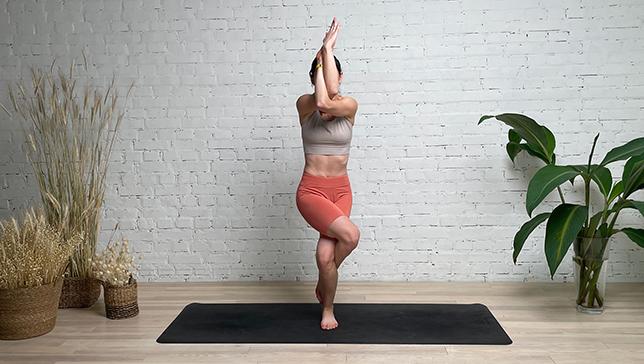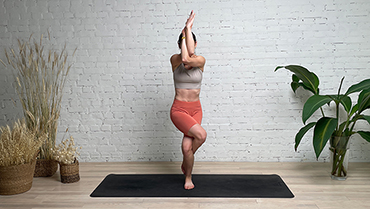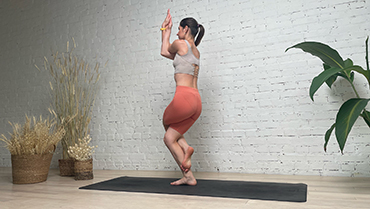Eagle Pose - Garudasana

Contents
Eagle Pose or Garudasana in Sanskrit (‘garuda’ = ‘eagle’ and ‘asana’ = ‘posture’) is a standing balancing pose that involves wrapping one leg around the other and crossing the arms in front of the body. Garuda is known as the king of the birds. Garudasana can help improve balance and coordination, stretch the shoulders and upper back, and tone the legs and glutes. It can also help calm the mind and improve focus.
Eagle Pose is considered a base pose as eagle pose variations can be derived from this pose. Eagle Pose helps boost energy in the body and hence can be included in different yoga sequences.
Pose Detail
- By Type: Balancing Yoga Poses, Flexibility Yoga Poses, Strengthening Yoga Poses
- Difficulty: Intermediate
- Body Position: Standing Yoga Poses
- By Benefit: Yoga Poses For Stress Relief
Step-by-Step Instructions
Benefits and Contraindications
Strengthens and stretches the ankles and calves
Stretches the thighs, hips, shoulders, and upper back
Improves concentration
Improves sense of balance
Avoid getting into this pose if you have any knee, elbow, ankle and wrist injury.
Not for women in later term pregnancy.
Photo poses in different angles


Useful Tips
There’s a lot going on in Eagle pose with the position of the arms and legs to think about all while you’re balancing on one leg. But you can break it down into separate elements to practice in isolation at first. For example:
- Learn the position of your arms while sitting at your desk (it’s a great stretch for your upper back while you’re working).
- Practice the wrapping of your legs while lying on your back or leaning against a wall for support.
- Build confidence in your balance by practicing Chair pose and lifting one foot slightly off the floor.
-
Whether you’re a beginner or not it can be challenging to hook your foot behind your calf in Eagle pose.
Instead you can just cross your leg over and point your foot to the floor – or rest it on the floor or a block for extra help with your balance. Keep squeezing your thighs together.
Frequently Asked Questions
Yes, beginners can practice Garudasana, but it’s important to start with the basics and focus on alignment and breath. If you have any injuries or limitations, make sure to consult with a qualified yoga teacher or healthcare professional before attempting the pose.
Garudasana engages several muscles including the quadriceps, hamstrings, glutes, calf muscles, deltoids, trapezius, rhomboids, and the muscles of the rotator cuff.
You can hold Garudasana for 5-10 breaths on each side, or longer if you feel comfortable. It’s important to listen to your body and avoid any discomfort or pain.
It’s best to avoid Garudasana during pregnancy, especially in the second and third trimesters. If you’re pregnant, make sure to consult with your healthcare provider and a qualified yoga teacher for modifications or alternative poses.
Some common mistakes to avoid in Garudasana include: collapsing the chest or rounding the shoulders, hunching the back, leaning too far forward or back, holding the breath, or gripping the toes too tightly. It’s important to focus on maintaining a steady breath, keeping the spine long, and finding a comfortable balance in the pose.
Variations
- Eagle Pose With Chair
- Eagle Arms Strap Close Up
- Eagle Pose Foot On Block
- Inverted Eagle Pose
- Extended Eagle Pose
- Seated Eagle Pose